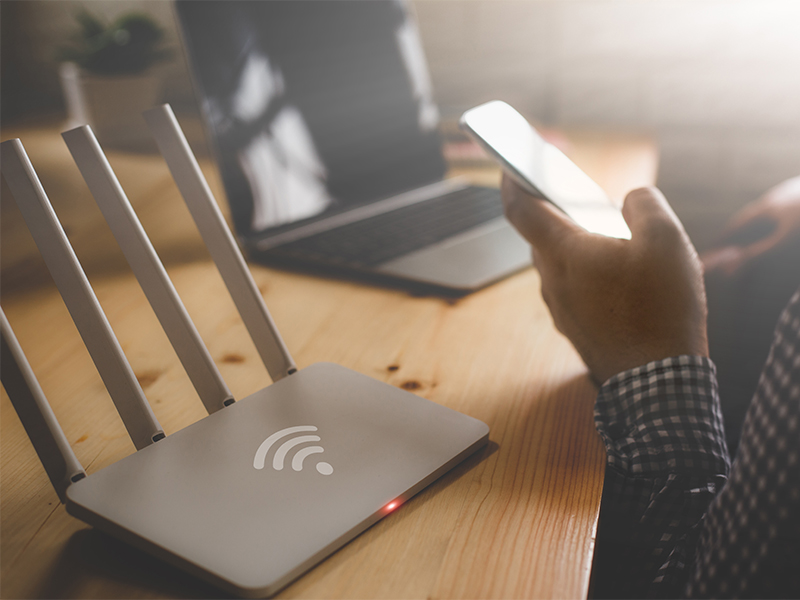Moving into a new place is disruptive enough, but when you discover your WiFi is connected but there’s no internet signal in a particular area (like your home office!), it just adds to the stress. Getting seamless internet connection and WiFi at home can be tricky due to the thick concrete reinforced walls here. However, there are some things to check and do while viewing properties – and before you sign the contract! – that could save you a heap of hassle and money. SARAH and BO from Tekkie Help share six tips.
#1 Check the location of the fibre termination box
One of the first things you should check when viewing a property is the location of the fibre termination point. This is where the property connects to the internet service provider’s fibre network – it’s a rectangular box with either “OpenNet” or “Netlink Trust” written on it.
Ideally, the fibre termination box should be located within the property. Moreover, check if there are data points and a power socket adjacent to it. Data points enable direct wired connections to other areas of the house, which provide faster and more stable internet compared to conections via WiFi at home.
#2 Consider the main router placement
The placement of the main router significantly influences signal strength and coverage. The main router will be located where the fibre termination box is and should be centrally located away from obstacles and things that will interfere with the signal such as walls and stairs.
If the termination point is in a basement or backroom away from your main living area, it will be especially important to check the house for data points and ensure that there is a data point and power socket next to the termination point.
If, instead, it’s awkwardly located and doesn’t have any data point next to it, request that the landlord relocate the fibre termination point to a more central location – this can be fairly costly work, so it’s important to try and get it done at their cost and not yours!
#3 Check for data points in rooms
Black spots, intermittent service and buffering are all fairly common when it comes to issues around having WiFi connected but no internet in Singapore. This is partly due to the dense structure of the concrete and reinforced steel buildings here. In order to get good coverage, routers need to be strategically placed around the home and hard-wired in. For this reason, when looking at properties, check that the rooms you need good coverage in have data points with an adjacent power socket. This will enable a router to be plugged in. It can then be connected back to the main router and modem using the internal wiring.
Older houses may not have data points installed. It’s sometimes possible to convert old telephone wiring to transmit data, so check if there are telephone sockets. It’s also possible to utilise old co-axial cable points. Simply plug in a small “MoCa box” at either end and then a router can plug into that. For the cable points to work, you also need a cable point to be positioned near the fibre termination box.
What if there are no data points, telephone sockets or cable points for your WiFi at home? We highly recommend you get a home IT services company to come and do a WiFi assessment to quote on the installation of data network cables. Tekkie Help provides complimentary WiFi assessments to Expat Living readers.
#4 Consider your home entertainment
These days, many of us rely on watching movies and TV shows via online sources such as Netflix. These require strong and stable internet connection. Thus it will be crucial that your TV is hard-wired to a router. Check where the television will be positioned and ensure there is a data point and power socket.
If there are no points at the location of the TV, it’s not ideal to run it on WiFi as you are likely to experience buffering in the streaming experience. Instead, you may wish to request that a data point is installed in the desired location.
#5 What about a mesh network?
As discussed, the best option is to have hard-wired WiFi access points in strategic locations using existing data points. If these aren’t available, or the landlord is not open to installing data cabling, another option is a “mesh network” such as Google WiFi or TP Link mesh sets.
These can be very effective in the right situations, for example if your WiFi is connected but you’re having internet issues. However, the mesh “nodes” must be within good WiFi range of each other so they can piggyback the signal. Concrete walls can hinder this, so it may be necessary to install additional nodes in corridors and stairwells. This helps bridge the signal between rooms or floors.
#6 Lease negotiations and budget considerations
Installing data cabling and moving fibre termination boxes can be costly. We strongly recommend that during the lease negotiation stage you get a quote from Tekkie Help to get seamless WiFi coverage. This way, you can request the landlord pays for the work. After all, it’s adding value to their property and bringing it up to the latest standards.
If your landlord is unwilling to invest, you’ll need to factor the costs of the work into your own budget and weigh up your options.
Securing reliable WiFi at home is pivotal in today’s connected world. Taking these steps during property viewing empowers you to make informed decisions. It could save you a heap of frustration and extra costs in situations where WiFi is connected but there’s no internet connection. It’ll ensure you enjoy a connected and convenient living experience.
Want to book a complimentary WiFi assessment? Or perhaps you need help with troubleshooting and optimising your WiFi at home? Get in touch with Sarah and Bo on 8113 8682 and quote “Expat Living”.
For more information, visit tekkiehelp.com.
This article first appeared in the December 2023 edition of Expat Living. You can purchase the latest issue or subscribe so you never miss a copy!
To make the most of living in Singapore, read our latest City Guide here for free! Here’s our expats guide to where to live in Singapore and the best things to do in Singapore.







